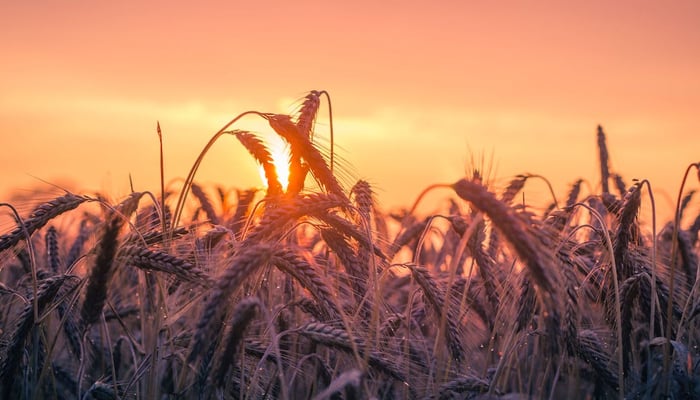Wheat crop at risk from severe drought: experts
One of the earliest driest Decembers was recorded in 1999 with 0.0mm
LAHORE: Pakistan’s wheat and other Rabi crops are facing a severe threat from an extended dry spell that has lasted for months, agriculture experts warned on Wednesday.
The country, which is largely dependent on agriculture for its food security, has received only 1.1 mm of rainfall in December 2023, a 92 percent drop from the average, according to the Meteorological Department.
One of the earliest driest Decembers was recorded in 1999 with 0.0mm. It was the year when a winter dry spell triggered severe drought conditions that hit agriculture hard in the next couple of years, following lack of rains at key growing seasons and lesser flows in rivers. The arid and rain-fed regions, which account for about 2.8 million acres of wheat cultivation, have been the worst hit by the drought, with production expected to be less than half of the normal level.
Met office data for December 2023 showed that Punjab witnessed only 0.2mm of rainfall, which is below 98 percent of the average, while Sindh recorded no rain except Jacobabad which reported only traces, Balochistan with 0.8mm or -94 percent, Khyber Pakhtonkhaw with 4.1mm, Gilgit Baltistant with only 0.3mm or -97 percent and the Azad Jammu & Kashmir with 7.4mm or -82 percent of the average rainfall, showing excessively below average wet conditions.
Ibrahim Mughal, chairman of Agri-Forum Pakistan said the biggest adverse impact of dry weather could be on wheat sown on about 2.8 million acres in the arid zone or rain-fed regions of the country. “With normal rains, output of up to 2.0-2.2 maunds per acre can be attained from barani wheat. However, if the current dry pattern is kept in mind, it is feared that hardly 8-10 maund per acre could be produced,” Mughal said.
The same is true for the case of other important Rabi crops of black gram sown in arid areas. National demand of black gram has increased to a million tons but lack of rain may reduce gram output to less than 0.4 million tons only if the present dry spell continues.
Canola crop is another important oilseed produce of Rabi, which is presently at stake due to low water availability on the back of a prolonged dry spell, he observed.
Talking about irrigated wheat, Mughal said that low temperatures are considered good for tillering but the crop is under drought stress at different places during the annual canal closure.
He, however, expressed relief that dry conditions had largely wiped out prospects of rust disease from wheat fields, recalling that this fungal disease has become a major threat to wheat crop for the last several months.
The humble wheat plant loves cold conditions during the early stages of the growth of the grain, as per agriculture experts. The heavy fog coupled with 3-5C temperature has very positive effects on wheat plants in the irrigated belt.
Although farmers have to bear additional costs due to watering fields out of tubewell water, it ensures sustainability of the crop in the dry spell.
However, Haji Ramzan of Kissan Board Pakistan is worried that lack of rain for a longer period is becoming a dangerous situation for the standing crop even in irrigated areas. He was of the view that such a discontinuity of the rains has seldom been witnessed in the past. In many places, it has been 60 to 100 days without rain.
"Wheat and other Rabi crops are in dire need of rain and productivity of the crop largely depends on rains. Rains in the month of January are considered crucial, especially during the tillering stage. A good wheat crop means a lot for farmers and other inhabitants of the country," he said, and added agriculture is not just a means of livelihood; it is a deep connection with the land and environment and a testament to the sustainable partnership between humans and nature.
"The ongoing dry spell leads to harsh weather conditions for the wheat crop, which is a food staple. I am praying for good rain to end this harsh weather and have nice sunny days with view to growing a healthy crop."
-
 Why Royal Lodge Fell Into Disarray Under Andrew: Insider Exposes Loophole
Why Royal Lodge Fell Into Disarray Under Andrew: Insider Exposes Loophole -
 Hoda Kotb 'so Proud' As Today 'magic Reignites' With Sheinelle Jones
Hoda Kotb 'so Proud' As Today 'magic Reignites' With Sheinelle Jones -
 Kate Middleton Avoids Nanny Involvmenet In Prince George Matters
Kate Middleton Avoids Nanny Involvmenet In Prince George Matters -
 Colin Jost Jokes About Scarlett Johansson Losing Highest-grossing Actor Crown To Zoe Saldana
Colin Jost Jokes About Scarlett Johansson Losing Highest-grossing Actor Crown To Zoe Saldana -
 ‘Traitor’ Prince Harry Has ‘spooked’ His Family: ‘He Has To Pay A Price Of Re-entry’
‘Traitor’ Prince Harry Has ‘spooked’ His Family: ‘He Has To Pay A Price Of Re-entry’ -
 Andrew’s Daughter Princess Eugenie Sparks Seismic Change After Stepping Away
Andrew’s Daughter Princess Eugenie Sparks Seismic Change After Stepping Away -
 Meghan Markle Shares NEW Photos From Day Out At The Zoo
Meghan Markle Shares NEW Photos From Day Out At The Zoo -
 'Game Of Thrones' New Series Returns To 'home'
'Game Of Thrones' New Series Returns To 'home' -
 Prince Harry Touches Down In Heathrow For The Witness Box
Prince Harry Touches Down In Heathrow For The Witness Box -
 Harry’s Turmoil Turns To Agony Over Meghan Markle’s Hope: ‘Time Will Tell If He’ll Bare It’
Harry’s Turmoil Turns To Agony Over Meghan Markle’s Hope: ‘Time Will Tell If He’ll Bare It’ -
 Reese Witherspoon Jokes About Jennifer Garner’s 'dark Side'
Reese Witherspoon Jokes About Jennifer Garner’s 'dark Side' -
 'Lion King' Co-director Roger Allers Breathes His Last At 76
'Lion King' Co-director Roger Allers Breathes His Last At 76 -
 Prince Harry’s Security ‘isn’t Just For His Family’: Expert Rewires Security Woe
Prince Harry’s Security ‘isn’t Just For His Family’: Expert Rewires Security Woe -
 Prince Harry Risks Making King Charles Choose Between Queen Camilla And Military Duty
Prince Harry Risks Making King Charles Choose Between Queen Camilla And Military Duty -
 Kate Hudson Jokes She May Write A Script To Star Alongside This Actress
Kate Hudson Jokes She May Write A Script To Star Alongside This Actress -
 Inside How Kate Middleton Stayed Steady Amid Cancer And Royal Chaos
Inside How Kate Middleton Stayed Steady Amid Cancer And Royal Chaos




